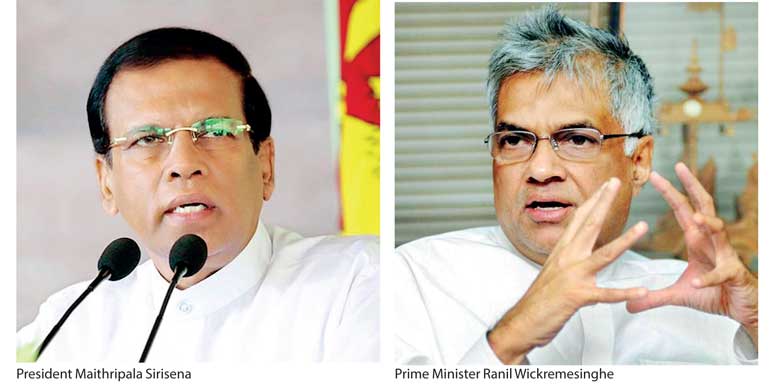Friday Mar 14, 2025
Friday Mar 14, 2025
Friday, 16 February 2018 00:00 - - {{hitsCtrl.values.hits}}

 What were the reasons for the governmental crisis? The UNP arrogantly attempted a political putsch. Having promised the people that it would form a UNP-only government if it won the 10 February election, which it was sure it would, the UNP then went on to make that attempt even after it resoundingly lost the election, securing 1.5 million votes less than in August 2015 and dropping by 13%.
What were the reasons for the governmental crisis? The UNP arrogantly attempted a political putsch. Having promised the people that it would form a UNP-only government if it won the 10 February election, which it was sure it would, the UNP then went on to make that attempt even after it resoundingly lost the election, securing 1.5 million votes less than in August 2015 and dropping by 13%.
In other words, having got a negative mandate for its slogan of a Government of Greens (plus the TNA), the UNP proceeded this week to threaten a grab for power. The UNP’s bid was/is a bloodless version of the anti-SLFP, anti-nationalist, rightwing coup attempt of 1962!
There was of course another, non-ideological dimension; one that was not present in 1962. A “pure UNP government” under its present leadership would hardly have been perceived as “pure”. Rather, it would be accurately seen by the President, the SLFP, the JO and the public as a Government of the Bond Scammers, by the Bond Scammers and for the Bond Scammers.
The SLFP reacted fast to pre-empt this scenario and was supported with conditions by the rising political power, Mahinda Rajapaksa’s SLPP-JO.
While the SLFP did worse than the UNP at the local election, it strongly felt that the debacle was the direct consequence of its close association with the UNP rather than its own deficiencies. This perception was well-founded in that their erstwhile colleagues and comrades in arms, the JO/SLPP had done extraordinarily well at the election by adopting an anti-UNP stance.
Since the SLFP and SLPP were together at the August 2015 parliamentary election, it wasn’t rocket science to figure out what had gone wrong since. It was the alliance with the UNP, and specifically with the polarising Prime Ministership of Ranil Wickremesinghe. The SLFP felt that not only was it paying for Ranil and Chandrika’s sins, it had also forfeited the chance of rapid electoral growth as demonstrably achieved by its former colleagues of the JO-SLPP.
The SLFP sees that between the SLPP and itself, they can garner a whopping 60%. This is an anti-UNP vote. Such a massive vote can see an SLPP-SLFP front easily winning any and all elections. All the SLFP needs to do is unhitch itself from the UNP which is an electoral millstone around its neck, and plug in with the SLPP which is on an upward parabola.
Hence the rebellion. It gave the UNP a chance: get rid of your radioactive leader as PM and we’ll stay with you, or else we’ll leave. The UNP chose to remain with Ranil Wickremesinghe as PM. It thereby ran the risk of losing power. However, in its arrogance which is based on its class prejudices and overestimation of the importance of Western backing, it thought it had eyeballed it with the SLFP and won. An example is the lead story on 14 February in EconomyNext, a sophisticated pro-UNP, pro-US website: “Sri Lanka PM outfoxes naive Sirisena, gets cracking” authored by its Political Correspondent. By the very next day, the axe was poised to fall.
What the UNP and its backers, local and foreign did not know, was that its slogan of a ‘pure UNP government’ or a UNP government backed by the TNA, would be perceived by both the SLFP and the SLPP-JO as a thinly disguised rightwing power grab; a peaceful coup. This threat perception would not have been so acute if the UNP had been led by a less polarising figure than Ranil Wickremesinghe, but the party had decided to stick with him. Therefore, the slogan of a UNP government sounded like an attempt to seize power and implement a program of the rapid sell off to the West and India, of strategic national locations and assets.
This swiftly brought about a convergence, however provisional, of the rival tendencies of the centre-left, namely the SLPP-JO and the SLFP, under an anti-UNP or anti-Ranil umbrella.
The Southern electoral tsunami and the consequent governmental crisis has understandably obscured from view, important new trends in Northern politics. These trends not only speak well of the Tamil people but open up the possibility of serious negotiations at a future date with a political front that represents the South far more fully than does the current Government.
In the all-important Jaffna District, the heartland of Tamil nationalism, a little over 18% of the vote at the recent local government election was obtained by a party led by a tough-minded pragmatist with solid anti-LTTE credentials — Douglas Devananda. In other words, Devananda’s party not only got over three times the percentage obtained by the JVP in the Sinhala areas, it got a significantly higher percentage than the official SLFP did with all the benefits of state — and executive presidential power.
It is impressive that while the five-party front, the ITAK, dominant in Tamil politics obtained 150 seats in the Jaffna District, 81 seats were won by Douglas Devananda’s EPDP.
EPDP has done relatively well in the Jaffna District. It captured two PS in the islands and increased its percentage of votes significantly. For the first time, it has members in all the districts in the North and almost all the districts in the North East. The EPDP has gone it alone. No one can now accuse EPDP of winning the votes with patronage. The Government was allied with the TNA, and the EPDP had no source of state patronage. Even more significantly, the EPDP has won votes and seats at a time when Tamil nationalism was running high, and Douglas scores low on the pure Tamil nationalism index.
The TNA vote has gone down significantly all over North and East. TNA cannot form administrations in any Jaffna councils without EPDP support. They are sending feelers to the EPDP. The All Ceylon Tamil Congress of Gajendrakumar has increased their vote share in Jaffna. They do not have any significant presence in other districts. The Suresh front contesting with TULF has not made any impression.
In the East, the TMVP of Pillayan has gained impressive votes in some areas of Batticaloa. The main national parties have also made their presence felt among Tamil voters though on a small scale.
Douglas Devananda is back and is a player in Tamil politics. Once again, Douglas comes into view as the last Tamil moderate standing, the sole viable negotiating partner for any Colombo administration whatsoever. He is the only one who will agree to the implementation of existing constitutional arrangements for devolution and won’t make dogmatic demands which sink their southern partners in government – as the TNA, propelled by hawkish civil society and Diaspora sentiment and funding, has just done to the UNP and SLFP.
The Yahapalana strategy and model of January 2015 was the alliance of the majority of the minority and the minority of the majority. That model didn’t work for either the majority or the minorities. Until we are able to unite the majority of the majority and the majority of the minority, perhaps we shall have to be satisfied with transitional arrangement that inverts the Yahapalana alliance of January 2015. We can try a combination of the majority of the majority and the (moderate) minority of the minority. That’s where Douglas Devananda and his EPDP come in.
Discover Kapruka, the leading online shopping platform in Sri Lanka, where you can conveniently send Gifts and Flowers to your loved ones for any event including Valentine ’s Day. Explore a wide range of popular Shopping Categories on Kapruka, including Toys, Groceries, Electronics, Birthday Cakes, Fruits, Chocolates, Flower Bouquets, Clothing, Watches, Lingerie, Gift Sets and Jewellery. Also if you’re interested in selling with Kapruka, Partner Central by Kapruka is the best solution to start with. Moreover, through Kapruka Global Shop, you can also enjoy the convenience of purchasing products from renowned platforms like Amazon and eBay and have them delivered to Sri Lanka.
Discover Kapruka, the leading online shopping platform in Sri Lanka, where you can conveniently send Gifts and Flowers to your loved ones for any event including Valentine ’s Day. Explore a wide range of popular Shopping Categories on Kapruka, including Toys, Groceries, Electronics, Birthday Cakes, Fruits, Chocolates, Flower Bouquets, Clothing, Watches, Lingerie, Gift Sets and Jewellery. Also if you’re interested in selling with Kapruka, Partner Central by Kapruka is the best solution to start with. Moreover, through Kapruka Global Shop, you can also enjoy the convenience of purchasing products from renowned platforms like Amazon and eBay and have them delivered to Sri Lanka.